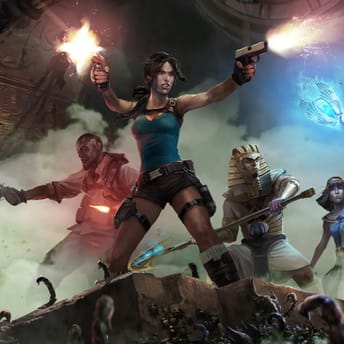Duke Nukem Forever’s Infamous 14-Year Development Hell Sparks New Drama

|
|
Key points
- Duke Nukem Forever’s 14-year-long development drama got a continuation 14 years after its launch.
- The game is playable on Xbox One and Xbox Series X|S via backward compatibility, as well as on macOS and Windows PCs via Steam.
- Duke Nukem Forever was released on June 14, 2011, following 14 years and 44 days of development.
Duke Nukem Forever’s 14-year-long development drama got a continuation as Digital Extremes’ COO revealed to the Eurogamer outlet why the company, now famous for Warframe, declined the offer to take over the game from its initial developer, 3D Realms.
Notably, the sequel to 1996’s Duke Nukem 3D is still playable on Xbox One and Xbox Series X|S via backward compatibility, as well as on macOS and Windows PCs via Steam, where it has a “Mostly Positive” rating with 6,019 reviews as of the time of writing.
As for the story of Duke Nukem Forever‘s development, it was announced by the initial developer studio 3D Realms, founded by Scott Miller, on April 27, 1997.
Due to the fact that the engine used for the previous title in the series, 1996’s Duke Nukem 3D, was antiquated, the game’s director George Broussard licensed id Software’s more advanced Quake II engine for about $500,000, reasoning it as a time-saving decision since writing a new engine is extremely time-consuming.
But because, at that exact moment, the Quake II engine was not finished, 3D Realms began development with the Quake engine, planning to migrate the game to the Quake II engine as soon as it was completed.
Broussard and Miller decided to fund Duke Nukem Forever using the profits from Duke Nukem 3D and other company’s titles, turning marketing and publishing rights over to GT Interactive.
The Quake II engine code reached 3D Realms in November 1997, half a year after game’s development began.
At the 1998 E3 conference, 3D Realms unveiled the first video footage of Duke Nukem Forever, crafted on the Quake II engine and showcasing Duke fighting on a moving truck and firefights with aliens.
In June 1998, 14 months after announcing that they would use the Quake II engine, 3D Realms switched production of the game to the Unreal Engine from Epic Games, as it was more realistic than the Quake II engine and better suited to producing open spaces, while the latter struggled to render the Nevada desert.
The decision regarding the second engine migration in two years was made unanimously in the company despite the fact that it led to discarding previously completed work, including significant changes made to the Quake II engine.
By the end of 1999, Duke Nukem Forever had missed several release dates and was far from finished, as half of its weapons remained concepts.
In 1999, Broussard decided to upgrade to a new version of the Unreal Engine designed for multiplayer. At the same time, the game’s publisher, GT Interactive, started facing heavy losses and was eventually purchased by Infogrames Entertainment, which led to Duke Nukem Forever’s publishing rights being passed to Gathering of Developers in early December 2000. The studio was shut down and absorbed into its parent company, Take-Two Interactive, three years later.
The game was presented one more time at E3 in 2001 with a new trailer showcasing a couple of minutes of footage, including a Las Vegas setting and a demonstration of the player interacting with a vending machine to buy a sandwich.
By 2003, only 18 people at 3D Realms were working on Duke Nukem Forever. Because the project was financed by the company itself, the developers were able to ignore pressure from their publisher and brush off the question of when Duke Nukem Forever would finally be shipped with a “when it’s done” reply.
In 2003, Take-Two CEO Jeffrey Lapin reported that the game would not be out that year and that the company was writing off $5.5 million from its earnings due to Duke Nukem Forever‘s lengthy development. Broussard responded to that with, “Take-Two needs to STFU imo.” Later that year, Lapin reported that 3D Realms was citing a Duke Nukem Forever release for the end of 2004 or the beginning of 2005.
In 2004, GameSpot reported that development of Duke Nukem Forever saw the fourth engine migration, this time to the Doom 3 engine which was soon denied by Broussard. But soon after that rumor surfaced, 3D Realms replaced the game’s Karma physics system with one designed by Meqon.
According to 3D Realms founder Scott Miller, around that point he approached the Canadian developers Digital Extremes, known for co-developing the Unreal games, to take over development of Duke Nukem Forever. Afterwards, on May 10, 2022, Miller declared that Digital Extremes and Take-Two were looking forward to such a deal, but the takeover was rejected internally at 3D Realms. Here, Duke Nukem Forever’s development drama got a continuation in July 2025, as Digital Extremes’ COO Sheldon Carter revealed to Eurogamer that his company declined the offer to take over the game because it was totally packed with the ongoing development of The Darkness II and BioShock at that time.
After the deal fell through, in 2006, in a filing with the U.S. Securities and Exchange Commission, Take-Two revealed they had renegotiated the Duke Nukem Forever deal, with Take-Two receiving $4.25 million instead of $6 million upon the game’s release. On top of that, Take-Two offered a $500,000 bonus to the developing company if Duke Nukem Forever launched in 2007. However, Broussard decalred that 3D Realms didn’t care about the bonus and would ‘never ship a game early.’
On December 19, 2007, 3D Realms released another Duke Nukem Forever trailer, the first in more than six years.
As Duke Nukem Forever approached completion, funding began to run dry. Having already invested over $20 million of their own funds, Broussard and Miller requested an additional $6 million from publisher Take-Two to finish the game. According to them, Take-Two initially agreed but later reduced the offer to $2.5 million. Take-Two, however, claimed it proposed $2.5 million upfront with another $2.5 million upon completion. Broussard rejected this arrangement, and on May 6, 2009, development of the game was suspended.
On May 8, 2009, 3D Realms laid off the Duke Nukem Forever development team due to a lack of funding. At the same time, Take-Two announced that while it retained the publishing rights to the game, it would not provide financial support to continue its development.
In 2009, Take-Two filed a lawsuit against 3D Realms over their failure to complete Duke Nukem Forever. By 2010, 3D Realms and Take-Two had settled the lawsuit and dismissed it with prejudice.
After 3D Realms stopped internal development of Duke Nukem Forever, nine former employees continued work independently as Triptych Games.
Gearbox CEO Randy Pitchford, who used to work on an expansion to Duke Nukem 3D, stepped in to help finish the game after 3D Realms approached Gearbox Software and asked if they were interested in helping Triptych Games polish the near-finished PC version and port it to consoles.
Pitchford secured funding, convinced 2K Games to support the effort, and hired Piranha Games to handle the console ports and multiplayer.
The game was re-announced at PAX 2010, where fans could play it for the first time. Gearbox eventually acquired the Duke Nukem IP, and 2K Games took on publishing duties.
After minor polishing, Duke Nukem Forever was released on June 14, 2011, following 14 years and 44 days of development, a record that was later surpassed by Beyond Good and Evil 2 in 2022, and then by Kien in 2024.




















